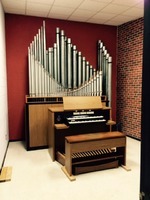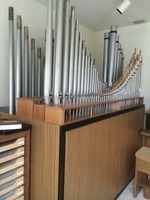I didn’t even know her name then, but I had to have her.
Aeolian-Skinner Opus 1457-B was one of identical twins contracted for Concordia Teachers College (now Concordia University) in Seward, Nebraska. Opus 1457-A is still there and being used regularly:
Op. 1457-B didn’t last long there, if she went at all. Only three years after contract date, B went to Clyde Holloway’s residence, where she stayed in regular use until Clyde’s death in December 2013:
After Clyde’s death, I couldn’t shake the notion of owning Op. 1457-B myself, having in my own home the instrument on which my teacher made his career while he was teaching me to make mine. I finally got up the nerve to write to Clyde’s executrix Kay Hartley and made an offer. Wheels began turning, and I retained an attorney friend in Houston to grease the skids as necessary. I would make a long story short here, but the story actually shortened itself! Kay called a very short time later, in June 2014, and said that the organ would be mine for the price I offered. Once I picked myself up off the floor, she and I discovered that we were both in Houston, and so I took a check over to her immediately, met her, and started making plans for moving the organ out. Ask, and ye shall receive.
I immediately called Tom Martin of the St. Dunstan-Art Organ Works in Houston, who had cared for my beloved Aeolian-Skinners at First Presbyterian, Houston. He and Kay started working out dates for crating, and I started working on dates for loading and hauling. As things began to come together, I realized that there was not going to be a good time for getting all this done. Fall semester was about to begin, and I had recitals nearly every weekend in September and October. So I made quite sure I was ready to play all those recitals well in advance, and we set a date for Labor Day.
I put out an appeal on Facebook for someone to ride shotgun in the Penske truck I was going to rent. Keith Weber won the prize (if you like to call such a thing a prize). Labor Day Sunday I flew to Houston and stayed with a dear friend Stephanie from First Presbyterian days. The next morning, Labor Day, we got up bright and rather early and made our way to Intercontinental Airport, where Keith was leaving his car for his return from the road trip. The three of us then made our way to pick up the truck, and I promised breakfast at the location of their choice. We ended up at the 59 Diner, an establishment that none of us frequented often enough over the years. Then Stephanie delivered Keith to his church to play a funeral (those things come up quickly), and I went to Clyde’s with the truck.
“Heavy” doesn’t begin to describe the weight of the chest, the console, and the crates containing the biggest pipes. But they all went down a flight of stairs and around two tight corners into the garage and into the truck. Another long story short: if you need movers in the Houston area, call Treasure Movers. Not a scratch, and nothing shifted in the truck during the trip.
Keith got a ride to Clyde’s from church, and we hit the road with Keith driving so I could rest up for when we dropped him off in Atlanta. Keith and I had never spent much time together, but within about ten minutes, we had the world in our cross hairs, and the discussions began. We solved a number of problems on behalf of crazy people everywhere. What a road trip! The best kind. We stopped for a delicious lunch at Steamboat Bill’s in Lake Charles. Beyond that, it was munchies only during fuel stops, which in a Penske truck are numerous.
Keith got out in Atlanta Tuesday at 4 am, and I carried on to Boone, N.C. I had made plans with one of my more responsible students that I would send him a text ninety minutes before my arrival, so that he could rally the troops to help unload. I arrived, and we started unloading. And unloading. And unloading. Hauling “an organ” kind of makes it sound like it’s all in one piece. Buzzer; thanks for playing.
I had made arrangements with Brad Rule to reassemble the organ. We set a date for later in September. Meanwhile, I walked around organ parts in my house for three weeks and took some time to get better acquainted with them. I organized things a bit better for reassembly and created better paths to the refrigerator and the bathroom.
Brad Rule arrived, and we set to work. The organ had been well marked which pieces go where, and after working out a minor leveling issue with the floor, it all went back together quite neatly. Electrically, we had to figure a few things out with the rectifier and the Zimbelstern, of all things. On top of that, the console had to be hard-wired back together, note by note. My wife Susan wins MVP: she soldered at least half the wires back into the console and proved once again to Brad Rule that women are sometimes the best help around.
Brad and I had to perform a surprising amount of voicing and regulating. Many of the taller pipes had been tubed off to offset chests to accommodate Clyde Holloway’s short ceilings in his homes over the years (see the photo above -- see those backmost pipes not standing on the main chest?). With tubing off, you sometimes have to open pipe toe holes to make the pipes speak promptly. But in my house, we had enough ceiling height to put the pipes back on the main chest, which meant that many of them were now a little too “hot” with wind. So we did a good bit of surgery on some toe holes and got everything back in order. Note to self: if you ever move again, make sure there is an 11-foot ceiling somewhere. Well, here is the finished product:
You can find the full spec and more technical/mechanical description here, in the Organ Historical Society organ database.
You can see a full photo journal of the move here, on my Facebook page.
The organ is two ranks: Gedeckt (97 notes) and Spitzflöte (85 notes). The Gedeckt changes its nature as you proceed up the scale, going from a Gedeckt in the bass to a Chimney Flute in the alto (notice the gold chimneys on the front of the chest, right side). The Spitzflöte changes toward a Gemshorn as you ascend, which renders it a successful surrogate “Principal,” as it were.
The action is a tracker imitation. I flipped the keyboards up to look at it only once and don't know much about it, but it is a pretty ingenious system that never wears out and stood up all those years to Clyde Holloway's legendary attacks and releases. It is a resistive action at first which then gives way to full attack, like a tracker. The downward key travel is surprisingly shallow for an electric action, but not surprisingly so for a tracker. Very interesting and very comfortable. All this was sort of the thing in those days, especially if the organ was originally destined for a Lutheran college in the Heartland, I suppose.
Now for the organ's name: I put out an appeal among my students and on Facebook for people to help me name her. She had to have a feminine name, of course. Beyond that, I felt that she should have two names, or at least a multi-syllabic one. It would also be good if her name/s could refer in some way to Aeolian-Skinner personnel or to me or to Clyde Holloway. The names started coming in, and my wheels started turning. Within about 2 days, I had it. You can follow the thread here.
Her name is Clara Belle. Her initials CB are Clyde Barrington Holloway’s first two initials. Her first name begins with ‘Cl’ as ‘Clyde’ does. Her second name is a version of mine and a nod to French, which style Clyde and I agreed was a specialty for us. Her double name nods to her current status as a good Southern girl. In addition, the console is nicknamed “Clyde,” not only for the obvious but also for the fact that that console has worked harder than a Clydesdale over the years. The bench is nicknamed “Big Mac,” in homage of Clyde’s love of all things Apple/Macintosh and for the fact that it is extremely heavy with a pecan top and formica structure.
Finally, Clara Belle stars in a two-part video series that shows in photos and tonal demonstration everything you have just read: here and here.
Clara Belle is a princess in my home, and she will give audience to any who wish to visit her.


